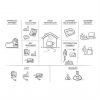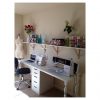Last week we talked about the basics you need to have and know before opening a fashion brand. Now, let’s discuss the business model, in other words, how your company is going to be commercially viable.
A great tool to help structure it is the Business Model Canvas, “a strategic management and entrepreneurial tool that allows you to describe, design, challenge, invent, and pivot your business model”. By the picture above, you can see that the by filling each section the essential questions about the business are answered. From your cost structure, to the customer segment, from sales channels to revenue streams, it is all here and you can change or adapt as much as you like or need. The most important thing is to have a 100% clear vision about every part. Here is a brief about them:
Value Proposition: start here, addressing the core of your business. What do you do and why it is unique? Clothes, accessories, shoes? Womenswear, childrenswear, wearable tech, sustainable fashion? Be as specific as you can and remember: in an oversaturated market, you must bring something new in order to stand out.
Key Partners: who will help make your idea turn into reality? List all the suppliers (from textile to web design companies) and think about any other businesses or people that you can collaborate with (department or multibrand stores, media outlets, bloggers that may promote the products, PRs…)
Key Activities: retail, wholesale or both? The costs of opening a store in the early stages of a brand are insane. E-commerce may be a good solution since it is a direct channel with clients. Wholesale is still the choice of revenue for many startups but can also be a great risk as the payment agreements are usually unfavourable to designers. Do a lot of research and consider each one carefully.
Key Resources: what do you need to run your business? Think materials, assets and even potential employees.
Cost Structure: studio rent, salaries, suppliers, manufacturing… Looking at the Key Resources and Activities you can have an idea of your fixed and variable costs. List all and use this space to evaluate where and when you can save or cut them.
Revenue Stream: how you will make money? Your revenues may vary a lot if you opt for wholesale instead of retail, for example. You can also have other sources of income, such as subscription model or licensing. Along with the Cost Structure this is an essential section to predict the chances of business viability, so be very careful and do the math!
Customer Relationships: how you will interact with a client? Of course, a physical store is no longer the only way. Social media is all around, is cost-effective and has global reach but requires planning (and hiring someone to be in charge). Advertising, PR, special events, customer assistance… Every touch point must be considered. Be creative and invest in cheaper but efficient alternatives to talk and get feedback (another essential practice to improve the business).
Distribution Channels: how your customer will buy a product? Again, think about the pros and cons of retail, wholesale and e-commerce. Additionally, list other possibilities: pop up store, trunk shows, sales by appointment, use of message apps such as WhatsApp… Again, don’t be limited by traditional models!
Customer Segment: who will buy your brand? Is it a mass market or niche product? Go beyond the classic demographics and focus on addressing desires instead of saying that your clothes are for ‘a 25 to 40 years old woman, who juggles career and family life’. Why not saying you create products for a woman with an explorer soul? This way you go deeper and offers the chance to fulfil an aspiration, attracting a more specific audience.
More explanations to help build the Business Model Canvas here
In the next post, it’s time to face the terrifying but necessary business plan!



3 thoughts on “How to Create a Brand? Step 2 – The Business Model”